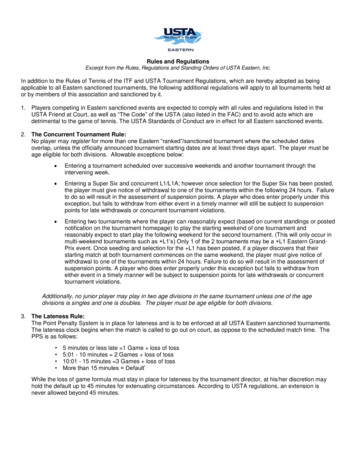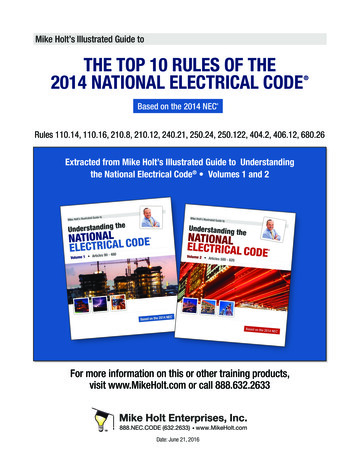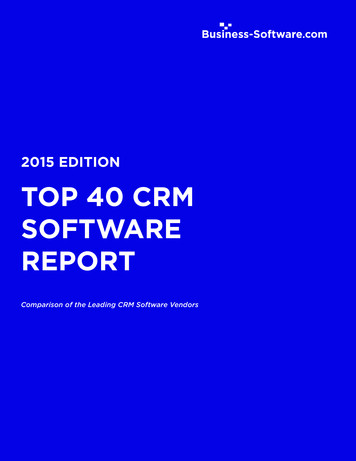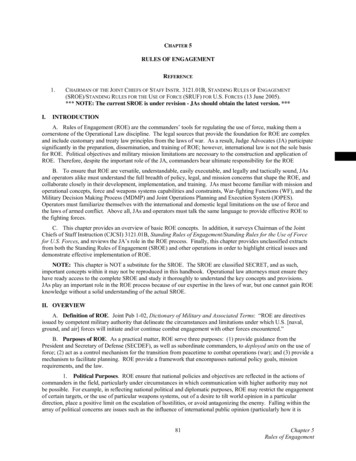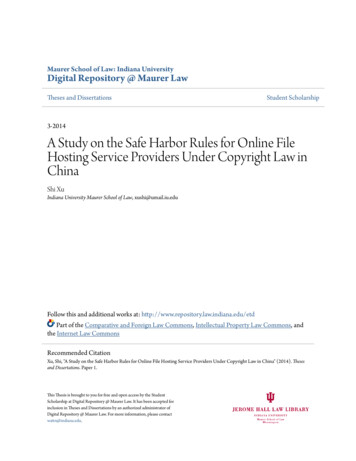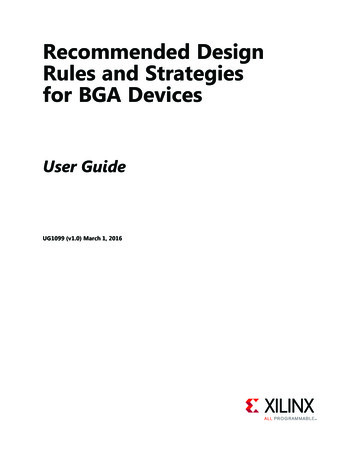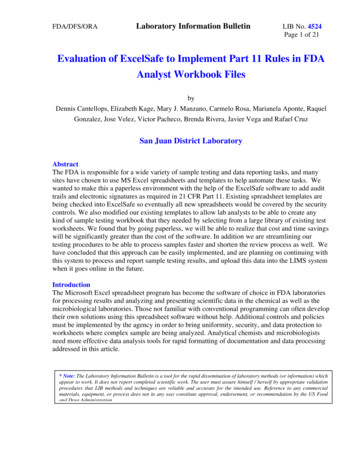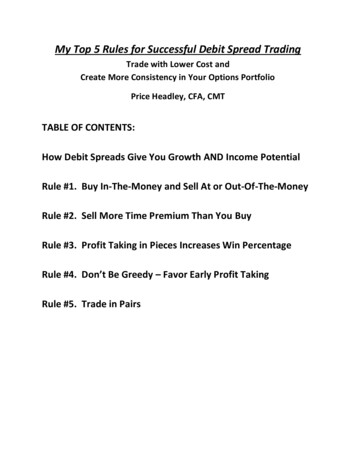
Transcription
My Top 5 Rules for Successful Debit Spread TradingTrade with Lower Cost andCreate More Consistency in Your Options PortfolioPrice Headley, CFA, CMTTABLE OF CONTENTS:How Debit Spreads Give You Growth AND Income PotentialRule #1. Buy In-The-Money and Sell At or Out-Of-The-MoneyRule #2. Sell More Time Premium Than You BuyRule #3. Profit Taking in Pieces Increases Win PercentageRule #4. Don’t Be Greedy – Favor Early Profit TakingRule #5. Trade in Pairs
How Debit Spreads Give You Growth AND Income PotentialIf you’ve ever bought an option before, you know that one of the challenges oftrading a time-limited asset is paying a “time premium” and overcoming the lossof time. And yet as a trader, I still see plenty of opportunities to take advantage oftrends on various time frames, from quick moves over a few days to “swingtrading” moves over several weeks. So how can you actually place time on yourside in the options game? It’s not by just selling options, as that can be profitable,but many traders have seen how a small number of trades can cause you lots oftrouble in option selling if a stock or market moves sharply against you.The answer that meets nicely in the middle – profiting from the growth potentialof catching a piece of an existing trend, while lowering your total cost percontract and paying no net time in your options – is Debit Spreads. You may haveheard them called Vertical Spreads, or Bull Call Spreads or Bear Put Spreads.A Debit Spread still requires a cash outlay for the trade, similar to purchasing aCall or Put. However, you are also selling another option in the same underlyinginstrument and same expiration (month or week), but with a different strikeprice.For a bullish spread, you are buying one Call and selling another Call with a higherstrike price against it. This is done simultaneously as a spread order – we do thiswith a limit entry price. We pay a certain price (or debit) for this trade, just as youwould with buying a Call or Put – with significant differences and advantages tothe ‘2-legged’ trade.First, let’s explore what types of options I like to purchase when I anticipate a bigshort-term directional trend move and what types of options to sell against that.
Rule #1. Buy In-The-Money and Sell At or Out-Of-The-MoneyYou of course want to find a healthy directional trend (I use technical analysis andsystemized trading rules in my Smart Options portfolio, where I do a weekly videoexplaining various forms of technical analysis to my subscribers) and I want tofocus you on the proper principles to construct an effective debit spread, wheretime is no longer your enemy. Now, we can place time on your side when donecorrectly with the Debit Spread.I first want to buy an “In-The-Money” or ITM option as my base, in order to createa “stock substitute” position. For example, say you have XYZ stock trading a 100per share. If you buy 100 shares of stock, that would cost you 10,000 up front.Instead I can buy a 95 strike call with 1 month before expiration for say, 600.That 1 options contract controls the same 100 shares of stock for just 6% of thestock cost. Of course, if you only bought the ITM option, you are looking at anintrinsic value of 500, and an extrinsic or “time value” remaining of 100. If thestock fails to move, you could be kissing that 100 goodbye in a month in a flatscenario.Here’s where I add a second layer to the initial ITM trade to turn it into a DebitSpread. For example, say I think the stock will go to 102 or higher in a month, fora 2% gain the stock. I could be conservative and sell the at-the-money (ATM) 100call 1 month out for 300, or I could be a bit more aggressive and sell the 1-month102 call for 200. Let’s look at both scenarios.The conservative income-only trader is looking to maximize the time premiumcollected, in this case lowering the cost on the 95 call down from 600 to a netoutlay of 300, cutting the total cost by 50%. That reduction in the net price percontract is the primary advantage of debit spreads. The main downside of theDebit Spread is that you cap your upside, in this case at a 200 maximum gain(100 strike sold – 95 strike bought 500 max gain minus 300 cost per spread
contract). So for a percentage return, your maximum profit would be 67% ( 500max/ 300 cost and of course you should factor in your commissions. Here inthis report we are not counting commissions for easier understanding).On the more aggressive alternative, you could sell the 102 call to give yourselfmore growth potential on the upside. The trade-off is you collect less timepremium up front, lowering your net cost to 400 vs. the original 600, a 33%reduction in your risk per contract. But now your maximum gain potential at 102or higher at the options’ expiration is 700 (102 strike sold – 95 strike purchased).So your maximum gain percentage at 102 or higher in this case is 75% (700/400).The entry and exit for the Debit Spread is done as one limit order (we don’trecommend market orders for spreads) and can be easily placed with your brokeror on your trading platform. Check with your broker to make sure your account isapproved for Debit Spread trading, which is typically simple to achieve becausethese are limited-risk trades.Here’s an example of a 95/100 call debit spread on Honeywell (HON), courtesy ofOptionsHouse.com:
Note that this HON example, and for Debit Spreads in general, you don’t want tojust “hold and hope” as you can lose your full cash outlay – exactly the same asstraight Call and Put buying. The odds of a maximum profit over 100 are muchhigher than the risk of a full loss, but we still want to control risk effectively. We’llcover rules for exits shortly.All the broker will require in terms of margin or cash is the initial debit you pay.Since we are both buying and selling an option at the same time (with the sameexpiration date but different strike prices), this can offer several advantages toregular call and put buying that we’ll delve into later in this report.There are other advantages to adding a premium-selling element into youroptions trading portfolio. It’s important to remember that for every option buyerthere is a seller of that exact contract – generally it will be a Market Maker on theother side of the trade. And just as you don’t always want to be Bullish (orBearish) in your trading, you also don’t always just want to be buying options andpaying for time premium.So by selling an option against the purchase to form a limited-risk Debit Spread,you incorporate option selling into your trading. And just as I prefer deep ITMoption buying, I also prefer to sell Out-Of-The-Money (OTM) and sometimes AtThe-Money (ATM) options against the ITM buy side. Both ATM and OTM optionsare made up of 100% time premium, priced based on the volatility of theunderlying stock (or “Vega”) and the time remaining (also called “Theta”).So with a Debit Spread strategy, you gain the benefit of selling an option againstthe in-the-money option you purchase, in a limited-risk environment. What otherbenefits does this strategy offer, and how does it differ from a straight optionpurchase in terms of risk/reward?
Rule #2. Sell More Time Premium Than You BuyEverybody likes a discount – whether it is real or perceived. For example, howmany shoppers buy more because of the 25%-off sale in a mall department store?But the bottom line is everyone prefers to have a smaller cash outlay whenmaking a trade.My method of Debit Spread trading offers this. Because you are both buying andselling an option at the same time, you lower the cost versus just buying anoption outright. But by how much?A rule of thumb is that generally our Buy ITM/Sell OTM debit spreads give a 10%or more ‘cash discount’ – but the smaller cash out-of-pocket per spread/contractcan be 30% or more in some cases! This allows a trader to either put out lesscash/risk for a particular trade or buy more contracts than they normally would.As an example, in BigTrends Smart Options (which offers real-time option traderecommendations to subscribers), 5 recent debit spread trade recommendationsoffered cash discounts of 26%, 18%, 22%, 15% and 12% versus if we just bought aCall or Put. This means less risk and less cash out of your pocket on each tradeyou make.Using the 26% cash discount real-life example, you could have bought an ITM Callfor 3.40 ( 340) and simultaneously sold an OTM Call against it for 0.90 ( 90). Thenet cost, or debit, of this trade was a limit price of 2.50 ( 250 per spread). Andwhat is maximum profit?Well simply, it is the difference between the strike prices minus the debit paid. Inthis example it was a 125/130 Call Spread (same expiration month). So themaximum this spread can be worth is 5.00 ( 500) and we paid 2.50 – thus themaximum profit potential in this example is 100%, not including commissions.So in addition to “saving” 90 per contract by doing a spread instead of just
buying the Call, we also have a gain potential of 100%. And we have lessened theoverall volatility of the position because we sold an option in addition to buyingone (more on this later).Also in this example where we bought the 125/130 Call Spread for 2.50, we arebasically ‘synthetically long’ at 127.50 – and guess where the underlying was atthe time right around 127.50! In this case, you take back all the time premiumyou paid for the 125 call with the time premium you sold in the 130 call. Andoften you can sell even more total time premium in the out-of-the-money optionthan you have to buy with the in-the-money choice. That way it’s like buying thestock at a discount, and truly putting time on your side.Rule #3. Profit Taking in Pieces Increases Win PercentageToo many traders take an “all or nothing” approach to trading. I’d rather takesome money off the table as the market makes it available to me, while stillshooting for a bigger gain on the rest of my position. So this has led to my “Halfand Half” strategy to generally book a first profit at approximately half of mymaximum potential gain. So if I have potential capped at 60%, I expect to book aprofit on the first half of my position at 30%.This also has ramifications for where I want to set my stop on the Debit Spread, aswell as how I manage my trailing stop to protect my profits and make sure theposition can result in an overall winner, even if the second half of the position hitsits trailing stop.For starters, if I expect a 60% gain on the final half of the position, there’s no waymy stop should be any looser than -30% initially. This keeps me with an initialprofit target of 2 times my risk, with the actual reward-to-risk closer to 1.5 timesrisk, since a 30% gain on half and 60% on the rest is an average gain of 45%.The other key is that once my first profit target is achieved, I raise my trailing stop
on the rest of my Debit Spread position to breakeven. This means that even if Iget taken out of the second half at 0% give or take, I’m still ahead of the game onaverage by 15% in this case ( 30% on half and 0% on half 15% on average).Certainly not a home run, but you can’t go broke taking a profit, as the old sayinggoes.Some worry about the stock surging past the upside strike price on the call sold. Ifthe stock does not look back, then you have to live with only making a 60% gainon the final piece rather than a bigger gain. This leads me to an importantphilosophy that you should seek to embody in your trading .Rule #4. Don’t Be Greedy – Favor Early Profit Taking“Bulls make money, Bears makes money, Pigs get slaughtered.”That old Wall Street maxim is always worth remembered, and I must admitsuccumbing to thinking I could squeeze more out of a Smart Options Debit Spreadin the past and it ended up costing me. Casino operator Wynn Reports (WYNN)gave me a clear breakdown signal based on my BigTrends indicators, and thetrade recommendation was part of the email sent to subscribers via email andtext and our debit spread instructions looked like this:September 5, 2014BTO the Goldman Sachs (GS) September 175 Call (GS 140920C175)and SIMULTANEOUSLYSTO the Goldman Sachs (GS) September 180 calls (GS 140920C180)for a net Debit of 3.00 or better for this debit spread.BTO the Wynn Resorts (WYNN) September 190 puts (WYNN 140920P190)and SIMULTANEOUSLYSTO the Wynn Resorts (WYNN) September 185 puts (WYNN 140920P185)for a net Debit of 3.00 or better for this debit spread.We were filled on WYNN that day at 3.00 (and Goldman at 3.00 too which was anice 63% winner, but I’m teaching about a trade I missed on with WYNN), for acost of 300 per contract plus commissions. We started making money on WYNNquickly, as the stock dropped from the initial level of 187.00 to under 173 on
September 16, the Tuesday of the expiration week. I thought surely I should beable to get filled near maximum value, with the stock a full 12 points under myshort strike of 185. So I figured I was giving the market a gift by trying to exit at4.90 rather than the full 5.00. But I could not get filled.And then faster than anyone could really expect, WYNN shares shot up that sameday to close around 179, then the next day near 183. I figured we’re still safeunder 185, then bam! The next morning the stock gapped up again and testednear 190, forcing me to scramble to place an exit at 2.40 which was filled for a 20% loss. This mistake of figuring I was safe to hold on forced me to tighten myfirst initial profit target and also implement tighter trailing stop rules ever since.The lesson: just because you’re in a less volatile Debit Spread, the stock can stillforce you to exit early or potentially risk a total loss if you hold on amid adversevolatility. If I had taken a bit less I could have still had a near 50% gain on that sidetoo. While the combined call with Goldman and put with WYNN was a successful“Pair trade” (more on that next), I still had to re-examine my rules to not leaveprofits on the table.
Wynn Resorts (WYNN) Daily Chart (area of September trade in dotted box)Rule #5. Trade in Pairs“The market can remain irrational longer than you can remain solvent.”I’ll admit that when I first started trading more than 25 years ago, I was a“plunger.” I’d do my analysis and make a big bet on my #1 favorite play, hoping tostrike it rich quick. And too often, some adverse market move would happen thatwould make my “home run” option idea suddenly at risk of a strikeout. I quicklyrealized that in order to stay in the game for the long haul, I needed to diversify,and risk a smaller amount of my stake on a variety of plays.As my analysis improved and I found patterns that allowed some stocks to staybullish and others to be bearish in the same market, I realized that the concept of“pairs trading” was indeed very viable. Originally pair trades were the foundation
of the hedge fund industry, where a hedge fund would buy a leading stock in asector and short a laggard in the same sector, to benefit from the performancedifferential while remaining hedged from sector and market risk. If the marketrose, the leader should gain more than the laggard, and if the market fell, thelaggard should lose more than the leader gave back.As I translated this concept to options, I realized that I could take a leading stockas a call and a relative dog as a put, and it did not have to be in the same sector aslong as the ideas are not correlated (for example, you would not want to be astock call and a bond put, as when stocks go down, the bonds should rise in aflight to safety, potentially placing you on both wrong sides). While there’s alwaysthe possibility that both a call and a put could lose, there’s also the opportunity tomake money on both sides of two different plays and offset the effects of apotentially volatile market environment.So now I prefer most every week to have both a Call Debit Spread and a Put DebitSpread to balance out the effects of our manic depressive markets. As in life,timing is everything in trading. So trend methods are very important. And it’s alsonice to smooth out the ride in getting to your desired destination, so the pairstrading approach tends to promote greater consistency and reduces the concernabout market gyrations.You may want to learn more about my BigTrends Smart Options portfolio, whereI focus exclusively on Debit Spreads, typically making 2 new recommendations perweek, or about 100 new trade ideas per year. And of course, I always send followups to my subscribers via email and also via text message with updates on whereto take profits or close down all open positions, along with weekly video updatesto help you learn while you earn.For more details on how you can start taking advantage of the many benefits ofDebit Spreads with Smart Options, just email us at clientcare@bigtrends.com orcall toll-free at 1-800-BIGTRENDS (800-244-8736).
The-Money (ATM) options against the ITM buy side. Both ATM and OTM options are made up of 100% time premium, priced based on the volatility of the underlying stock (or Vega _) and the time remaining (also called Theta _). So with a Debit Spread st
